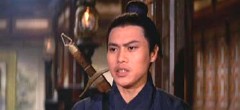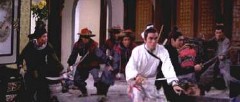A decent Wu Xia Pian, but more because of its naivety than anything else...
If you are looking for a memorable Chang Cheh Wu Xia Pian, Magnificent Trio is not really what you need. It's more some kind of rough work preparing for the classics. The fights are not memorable, nor the story or the acting. However, Shaw Brothers fans should have a look at it for some reasons.
First reason, Wang Yu, who is trying so hard during all the movie to be an impassive hero, but who just looks funny and expressionless. Especially when you compare him with Lo Lieh, already impressive in one of his very first movie. Of course Wang Yu has always the kind of character that would fit Lo Lieh much better, leaving him a less interesting supporting role.
The other good reason to watch this movie is the naivety. There are many funny scenes, with a naive romance between a widow (who forgets quite quickly her husband) and one of the three heros, and the awkward style of the fights (far from realistic, with the usual "don't worry I'm fine" each time a fighter has an arrow or a sword sticked in the chest). All the movie is shot in studio, giving him another very old fashioned touch.
In few words, if you want to see a very convincing hero movie by Chang Cheh, forget about this one. If you want to know more about the roots of this genre and have some fun with a very ingenuous movie, this one is for you.
An entertaining epic in its own right.
The Magnificent Trio is the remake of Hideo Gosha’s celebrated debut feature Three Outlaw Samurai, released only a few years earlier in Japan. The first obvious challenge of the film was to transpose the stern black and white universe of Gosha’s chambara into this typical Shaw brothers color-laden production. The title itself hints at Sturges’ Magnificent Seven, another adaptation from the Japanese classic The Seven Samurai, and the process seemed to be widespread at the time, as Sergio Leone already had his own version of Yojimbo.
The present attempt is far from being a failure, thanks to a subtil remodelling of the plot, which allowed the movie to fit in the new martial chivalry trend ensuing Chui Chang Wang’s Temple of the Red Lotus, on which Chang Cheh also collaborated. Whereas the general theme is identical to its Japanese counterpart, (valiant swordsmen offering protection to overburdened peasants), the film manages to take on a classic Chinese feel, thanks to the gorgeous arrays and paraphernalia (watch that cute water mill), as well as the wire stunts performed here and there. The main problem comes from never really having the trio working as such, making the title quite a misnomer. Wang Yu, Lo Lieh, and the bulky Cheng Lui all have their share of heroism in the film, but except for the choreographed opening credit sequence and another short passage, the three of them are never really brought together. On the other hand, the movie’s main quality is to have its end totally branched off from the original, thanks to the extended use of the hairpin and the petition, already key instruments in Gosha’s film.
wire stunts performed here and there. The main problem comes from never really having the trio working as such, making the title quite a misnomer. Wang Yu, Lo Lieh, and the bulky Cheng Lui all have their share of heroism in the film, but except for the choreographed opening credit sequence and another short passage, the three of them are never really brought together. On the other hand, the movie’s main quality is to have its end totally branched off from the original, thanks to the extended use of the hairpin and the petition, already key instruments in Gosha’s film.
The final battle scene resulting from this modification is far from the gory finales which would later characterize Chang Cheh’s work, but is still an enduring one, with the white-clad Wang Yu deflecting a number of arrows with his sword and the black-clad Lo Lieh skilfully thrusting back his adversaries, before they find themselves pressed together back to back by their encircling enemies : the arch-heroic situation Gosha’s movie almost lacked. Comparisons put aside, that movie should definitely be regarded as a classic Hong Kong epic, obviously surpassed by Chang Cheh’s following films, but whose quaintness makes it all the more enjoyable.
before they find themselves pressed together back to back by their encircling enemies : the arch-heroic situation Gosha’s movie almost lacked. Comparisons put aside, that movie should definitely be regarded as a classic Hong Kong epic, obviously surpassed by Chang Cheh’s following films, but whose quaintness makes it all the more enjoyable.




